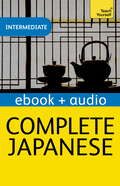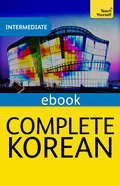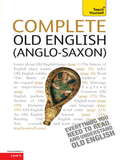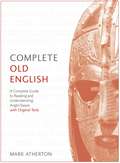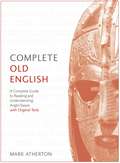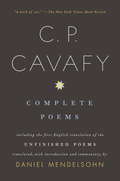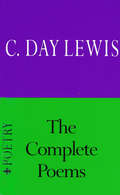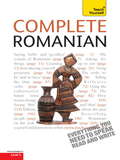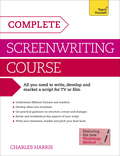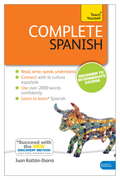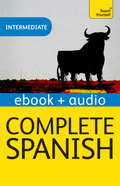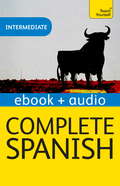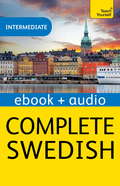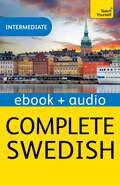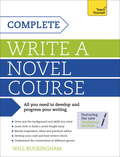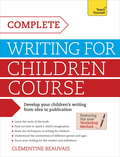- Table View
- List View
Complete Italian: Teach Yourself
by Lydia Vellaccio Maurice ElstonComplete Italian is a comprehensive language course that takes you from beginner to intermediate level.This ebook just features text. An ebook + audio edition is also available with the ISBN 9781444154740.The new edition of this successful course has been fully revised and is packed with new learning features to give you the language, practice and skills to communicate with confidence.-Maps from A1 to B2 of the Common European Framework of Reference (CEFR) for languages-25 learning units plus test section -Discovery Method - figure out rules and patterns to make the language stick-Teaches the key skills - reading, writing, listening and speaking-Learn to learn - tips and skills on how to be a better language learner-Culture notes - learn about the people and places of Italy-Outcomes-based learning - focus your studies with clear aims-Authentic listening activities - everyday conversations give you a flavour of real spoken Italian-Test Yourself - see and track your own progressRely on Teach Yourself, trusted by language learners for over 75 years.uble CD (9781444100143).
Complete Japanese Beginner to Intermediate Book and Audio Course: Enhanced Edition
by Helen GilhoolyComplete Japanese is a comprehensive ebook + audio language course that takes you from beginner to intermediate level. The main body of this ebook is written in Romanized script. Each unit also offers reading practice in the Japanese scripts: hiragana, katakana and some simple kanji. This updated edition of this successful course has been fully revised and is packed with new learning features to give you the language, practice and skills to communicate with confidence. -Maps from A1 to B1 of the Common European Framework of Reference (CEFR) for languages -13 learning units plus verb tables and word glossaries -Discovery Method - figure out rules and patterns to make the language stick -Teaches the key skills - reading, writing, listening and speaking -Topic based-approach - learn Japanese you can actually use -Reading activities in Japanese scripts throughout -Learn to learn - tips and skills on how to be a better language learner -Culture notes - learn about the people and places of Japan -Outcomes-based learning - focus your studies with clear aims -Authentic listening activities - everyday conversations give you a flavour of real spoken Japanese -Test Yourself - see and track your own progress Rely on Teach Yourself, trusted by language learners for over 80 years.
Complete Japanese Beginner to Intermediate Book and Audio Course: Enhanced Edition
by Helen GilhoolyComplete Japanese is a comprehensive ebook + audio language course that takes you from beginner to intermediate level. The main body of this ebook is written in Romanized script. Each unit also offers reading practice in the Japanese scripts: hiragana, katakana and some simple kanji. The new edition of this successful course has been fully revised and is packed with new learning features to give you the language, practice and skills to communicate with confidence. -Maps from A1 to B1 of the Common European Framework of Reference (CEFR) for languages -13 learning units plus verb tables and word glossaries -Discovery Method - figure out rules and patterns to make the language stick -Teaches the key skills - reading, writing, listening and speaking -Topic based-approach - learn Japanese you can actually use -Reading activities in Japanese scripts throughout -Learn to learn - tips and skills on how to be a better language learner -Culture notes - learn about the people and places of Japan -Outcomes-based learning - focus your studies with clear aims -Authentic listening activities - everyday conversations give you a flavour of real spoken Japanese -Test Yourself - see and track your own progress Coming soon: get our companion app. Japanese course: Teach Yourself is full of fun, interactive activities to support your learning with this course. Apple and Android versions available. Rely on Teach Yourself, trusted by language learners for over 70 years.
Complete Korean Beginner to Intermediate Course: eBook: New edition
by Jaehoon Yeon Mark VincentComplete Korean is a comprehensive ebook language course that takes you from beginner to intermediate level. Please note that this ebook contains the text only and no audio content.The new edition of this successful course has been fully revised and is packed with new learning features to give you the language, practice and skills to communicate with confidence. -Maps from A1 to B2 of the Common European Framework of Reference (CEFR) for languages-Korean script (Hangul) used throughout - for real language immersion -Discovery Method - figure out rules and patterns to make the language stick -Teaches the key skills - reading, writing, listening and speaking -Learn to learn - tips and skills on how to be a better language learner -Culture notes - learn about the people and places of Korea -Outcomes-based learning - focus your studies with clear aims-Test Yourself - see and track your own progress Coming soon: get our companion app. Korean course: Teach Yourself is full of fun, interactive activities to support your learning with this course. Apple and Android versions available. Also available: Get Started in Korean (ISBN 9781444175042). Rely on Teach Yourself, trusted by language learners for over 75 years.This ebook is compatible with iPad, Kindle Paperwhite, Kindle Fire and Kindle Fire HD.
Complete Old English: A Comprehensive Guide to Reading and Understanding Old English, with Original Texts
by Mark AthertonThis product is most effective when used in conjunction with the corresponding double CD.- You can purchase the book and double CD as a pack (ISBN: 9781444104196)@font-face {}p.MsoNormal, li.MsoNormal, div.MsoNormal { margin: 0cm 0cm 0.0001pt; font-size: 12pt; font-family: ""Times New Roman""; }div.Section1 { page: Section1; }- The double CD is also sold separately (ISBN: 9781444104202)Learn Old English (Anglo-Saxon) with this best-selling course from Teach Yourself - the No. 1 brand in language learning. Equally suited to general reader, historian and student of literature, this new edition teaches vocabulary and grammar through original texts, with audio support, traces the roots of modern English words, and explores the Anglo-Saxon cultural context through poems, prose and historical documents.Learn effortlessly with a new easy-to-read page design and interactive features: NOT GOT MUCH TIME?One-, five- and ten-minute introductions to key principles to get you started.AUTHOR INSIGHTSLots of instant help with common problems and quick tips for success, based on the author's many years of experience.GRAMMAR TIPSEasy-to-follow building blocks to give you a clear understanding.USEFUL VOCABULARYEasy to find and learn, to build a solid foundation for understanding.TEST YOURSELFTests in the book and online to keep track of your progress.EXTEND YOUR KNOWLEDGEExtra online articles to give you a richer understanding of the culture and history of Anglo-Saxon England.
Complete Old English: A Comprehensive Guide to Reading and Understanding Old English, with Original Texts
by Mark AthertonThis product is most effective when used in conjunction with the corresponding double CD.- You can purchase the book and double CD as a pack (ISBN: 9781444104196)@font-face {}p.MsoNormal, li.MsoNormal, div.MsoNormal { margin: 0cm 0cm 0.0001pt; font-size: 12pt; font-family: ""Times New Roman""; }div.Section1 { page: Section1; }- The double CD is also sold separately (ISBN: 9781444104202)Learn Old English (Anglo-Saxon) with this best-selling course from Teach Yourself - the No. 1 brand in language learning. Equally suited to general reader, historian and student of literature, this new edition teaches vocabulary and grammar through original texts, with audio support, traces the roots of modern English words, and explores the Anglo-Saxon cultural context through poems, prose and historical documents.Learn effortlessly with a new easy-to-read page design and interactive features: NOT GOT MUCH TIME?One-, five- and ten-minute introductions to key principles to get you started.AUTHOR INSIGHTSLots of instant help with common problems and quick tips for success, based on the author's many years of experience.GRAMMAR TIPSEasy-to-follow building blocks to give you a clear understanding.USEFUL VOCABULARYEasy to find and learn, to build a solid foundation for understanding.TEST YOURSELFTests in the book and online to keep track of your progress.EXTEND YOUR KNOWLEDGEExtra online articles to give you a richer understanding of the culture and history of Anglo-Saxon England.
Complete Old English: Apple Enhanced Edition
by Mark AthertonDesigned for complete beginners, and tested for years with real learners, Complete Old English offers a bridge from the textbook to the real world, enabling you to learn the grammar, understand the vocabulary and even how to translate such canonical texts as Beowulf and the earliest version of the Lord's Prayer from a critical point in our history.Structured around authentic material, using online audio to aid pronunciation, and introducing both a grammar perspective and a full introduction to essential vocabulary, this course also features: -22 learning units plus maps and verb guide-New edition features key set texts in an Appendix, in a title suitable for classroom or self-study use-Authentic materials - language taught through key texts-Teaches the key skills - reading and understanding Old English grammar and vocabulary-Culture insights - learn about the culture and religion of the Anglo-Saxons-Self tests and learning activities - see and track your own progressRely on Teach Yourself, trusted by language learners for over 75 years.
Complete Old English: Enhanced Edition
by Mark AthertonDesigned for complete beginners, and tested for years with real learners, Complete Old English offers a bridge from the textbook to the real world, enabling you to learn the grammar, understand the vocabulary and even how to translate such canonical texts as Beowulf and the earliest version of the Lord's Prayer from a critical point in our history.Structured around authentic material, using online audio to aid pronunciation, and introducing both a grammar perspective and a full introduction to essential vocabulary, this course also features: -22 learning units plus maps and verb guide-New edition features key set texts in an Appendix, in a title suitable for classroom or self-study use-Authentic materials - language taught through key texts-Teaches the key skills - reading and understanding Old English grammar and vocabulary-Culture insights - learn about the culture and religion of the Anglo-Saxons-Self tests and learning activities - see and track your own progressRely on Teach Yourself, trusted by language learners for over 75 years.
Complete Poems
by Daniel Mendelsohn C. P. CavafyAn extraordinary literary event: Daniel Mendelsohn's acclaimed two-volume translation of the complete poems of C. P. Cavafy--including the first English translation of the poet's final Unfinished Poems--now published in one handsome edition and featuring the fullest literary commentaries available in English, by the renowned critic, scholar, and international best-selling author of The Lost. No modern poet so vividly brought to life the history and culture of Mediterranean antiquity; no writer dared break, with such taut energy, the early-twentieth-century taboos surrounding homoerotic desire; no poet before or since has so gracefully melded elegy and irony as the Alexandrian Greek poet Constantine Cavafy (1863-1933). Whether advising Odysseus on his return to Ithaca or confronting the poet with the ghosts of his youth, these verses brilliantly make the historical personal--and vice versa. To his profound exploration of longing and loneliness, fate and loss, memory and identity, Cavafy brings the historian's assessing eye along with the poet's compassionate heart. After more than a decade of work and study, Mendelsohn--a classicist who alone among Cavafy's translators shares the poet's deep intimacy with the ancient world--gives readers full access to the genius of Cavafy's verse: the sensuous rhymes, rich assonances, and strong rhythms of the original Greek that have eluded previous translators. Complete with the Unfinished Poems that Cavafy left in drafts when he died--a remarkable, hitherto unknown discovery that remained in the Cavafy Archive in Athens for decades--and with an in-depth introduction and a helpful commentary that situates each work in a rich historical, literary, and biographical context, this revelatory translation is a cause for celebration: the definitive presentation of Cavafy in English.
Complete Poems
by Cecil Day-LewisTogether with Auden, Spender and MacNeice, C. Day Lewis was one of the leading young poets who in the 1930s broke away from the poetic establishment of those days. Day Lewis started writing poetry very young and, despite an active career which embraced schoolmastering , journalism, publishing, academic lecturing and the writing of detective stories, his devotion to poetry never wavered. Always prolife, he continued to write to the end of his days, so that when he died in 1972, having held the Chair of Poetry at Oxford from 1951 and 1956 and having been appointed Poet Laureate in 1968, he left behind a very large and varied body of work.Here, for the first time, are all the poems Day Lewis wrote, including the vers d'occasion which have never previously appeared in book form and a number of works which have only been published in a limited edition before now.
Complete Romanian Beginner to Intermediate Course: Learn to read, write, speak and understand a new language with Teach Yourself
by Dennis Deletant Yvonne AlexandrescuAre you looking for a complete course in Romanian which takes you effortlessly from beginner to confident speaker? Whether you are starting from scratch, or are just out of practice, Complete Romanian will guarantee success!Now fully updated to make your language learning experience fun and interactive. You can still rely on the benefits of a top language teacher and our years of teaching experience, but now with added learning features within the course and online. The course is structured in thematic units and the emphasis is placed on communication, so that you effortlessly progress from introducing yourself and dealing with everyday situations, to using the phone and talking about work. By the end of this course, you will be at Level B2 of the Common European Framework for Languages: Can interact with a degree of fluency and spontaneity that makes regular interaction with native speakers quite possible without strain for either party.Learn effortlessly with a new easy-to-read page design and interactive features: NOT GOT MUCH TIME?One, five and ten-minute introductions to key principles to get you started.AUTHOR INSIGHTSLots of instant help with common problems and quick tips for success, based on the author's many years of experience.GRAMMAR TIPSEasy-to-follow building blocks to give you a clear understanding.USEFUL VOCABULARYEasy to find and learn, to build a solid foundation for speaking.DIALOGUESRead and listen to everyday dialogues to help you speak and understand fast.PRONUNCIATIONDon't sound like a tourist! Perfect your pronunciation before you go.TEST YOURSELFTests in the book and online to keep track of your progress.EXTEND YOUR KNOWLEDGEExtra online articles to give you a richer understanding of the culture and history of Romania.TRY THISInnovative exercises illustrate what you've learnt and how to use it.
Complete Romanian Beginner to Intermediate Course: Learn to read, write, speak and understand a new language with Teach Yourself
by Dennis Deletant Yvonne AlexandrescuAre you looking for a complete course in Romanian which takes you effortlessly from beginner to confident speaker? Whether you are starting from scratch, or are just out of practice, Complete Romanian will guarantee success!Now fully updated to make your language learning experience fun and interactive. You can still rely on the benefits of a top language teacher and our years of teaching experience, but now with added learning features within the course and online. The course is structured in thematic units and the emphasis is placed on communication, so that you effortlessly progress from introducing yourself and dealing with everyday situations, to using the phone and talking about work. By the end of this course, you will be at Level B2 of the Common European Framework for Languages: Can interact with a degree of fluency and spontaneity that makes regular interaction with native speakers quite possible without strain for either party.Learn effortlessly with a new easy-to-read page design and interactive features: NOT GOT MUCH TIME?One, five and ten-minute introductions to key principles to get you started.AUTHOR INSIGHTSLots of instant help with common problems and quick tips for success, based on the author's many years of experience.GRAMMAR TIPSEasy-to-follow building blocks to give you a clear understanding.USEFUL VOCABULARYEasy to find and learn, to build a solid foundation for speaking.DIALOGUESRead and listen to everyday dialogues to help you speak and understand fast.PRONUNCIATIONDon't sound like a tourist! Perfect your pronunciation before you go.TEST YOURSELFTests in the book and online to keep track of your progress.EXTEND YOUR KNOWLEDGEExtra online articles to give you a richer understanding of the culture and history of Romania.TRY THISInnovative exercises illustrate what you've learnt and how to use it.
Complete Screenwriting Course: A complete guide to writing, developing and marketing a script for TV or film
by Charles HarrisDesigned to take you from the moment you first put your pen to paper to pitching and selling your completed screenplay, this is one of the most inspiring books on screenwriting you'll ever read.Practical exercises will teach you the craft of writing for film and television, both mainstream and independent, the art of building your own plots, characters, dialogue and scenes. It gives you the skills you need to succeed and helps you critique your own work, meaning that at every step of the writing process you'll be producing the best scripts you can.This book is filled with essential writing tools, including techniques for overcoming writer's block and how to find your unique voice. You will learn how to pitch and get your work optioned, how to work as part of a team and how to make the best use of social media - in all a comprehensive companion that you will keep coming back to as your career develops.ABOUT THE SERIESThe Teach Yourself Creative Writing series helps aspiring authors tell their stories. Covering a range of genres from science fiction and romantic novels to illustrated children's books and comedy, this series is packed with advice, exercises, and tips for unlocking creativity and improving your writing. And because we know how daunting the blank page can be, we set up the Just Write online community, at tyjustwrite.com, for budding authors and successful writers to connect and share.
Complete Screenwriting Course: Teach Yourself
by Charles HarrisDesigned to take you from the moment you first put your pen to paper to pitching and selling your completed screenplay, this is one of the most inspiring books on screenwriting you'll ever read. Practical exercises will teach you the craft of writing for film and television, both mainstream and independent, the art of building your own plots, characters, dialogue and scenes. It gives you the skills you need to succeed and helps you critique your own work, meaning that at every step of the writing process you'll be producing the best scripts you can. This book is filled with essential writing tools, including techniques for overcoming writer's block and how to find your unique voice. You will learn how to pitch and get your work optioned, how to work as part of a team and how to make the best use of social media - in all a comprehensive companion that you will keep coming back to as your career develops.
Complete Spanish (Learn Spanish with Teach Yourself)
by Juan Kattan-IbarraComplete Spanish is a comprehensive language course that takes you from beginner to intermediate level.This ebook just features text. An ebook + audio edition is also available with the ISBN 9781444154726.The new edition of this successful course has been fully revised and is packed with new learning features to give you the language, practice and skills to communicate with confidence.-Maps from A1 to B2 of the Common European Framework of Reference (CEFR) for languages-25 learning units plus taking it further section-Discovery Method - figure out rules and patterns to make the language stick-Teaches the key skills - reading, writing, listening and speaking-Learn to learn - tips and skills on how to be a better language learner-Culture notes - learn about the people and places of Spain-Outcomes-based learning - focus your studies with clear aims-Authentic listening activities - everyday conversations give you a flavour of real spoken Spanish-Test Yourself - see and track your own progressRely on Teach Yourself, trusted by language learners for over 75 years.
Complete Spanish (Learn Spanish with Teach Yourself): Enhanced eBook: New edition
by Juan Kattan-IbarraComplete Spanish is a comprehensive ebook + audio language course that takes you from beginner to intermediate level.The new edition of this successful course has been fully revised and is packed with new learning features to give you the language, practice and skills to communicate with confidence.-Maps from A1 to B2 of the Common European Framework of Reference (CEFR) for languages-25 learning units plus taking it further section-Discovery Method - figure out rules and patterns to make the language stick-Teaches the key skills - reading, writing, listening and speaking-Learn to learn - tips and skills on how to be a better language learner-Culture notes - learn about the people and places of Spain-Outcomes-based learning - focus your studies with clear aims-Authentic listening activities - everyday conversations give you a flavour of real spoken Spanish-Test Yourself - see and track your own progressRely on Teach Yourself, trusted by language learners for over 75 years.
Complete Spanish (Learn Spanish with Teach Yourself): Enhanced eBook: New edition
by Juan Kattan-IbarraComplete Spanish is a comprehensive ebook + audio language course that takes you from beginner to intermediate level.The new edition of this successful course has been fully revised and is packed with new learning features to give you the language, practice and skills to communicate with confidence.-Maps from A1 to B2 of the Common European Framework of Reference (CEFR) for languages-25 learning units plus taking it further section-Discovery Method - figure out rules and patterns to make the language stick-Teaches the key skills - reading, writing, listening and speaking-Learn to learn - tips and skills on how to be a better language learner-Culture notes - learn about the people and places of Spain-Outcomes-based learning - focus your studies with clear aims-Authentic listening activities - everyday conversations give you a flavour of real spoken Spanish-Test Yourself - see and track your own progressRely on Teach Yourself, trusted by language learners for over 75 years.
Complete Spanish (Learn Spanish with Teach Yourself): New edition
by Juan Kattan-IbarraComplete Spanish is a comprehensive language course that takes you from beginner to intermediate level.This ebook just features text. An ebook + audio edition is also available with the ISBN 9781444154726.The new edition of this successful course has been fully revised and is packed with new learning features to give you the language, practice and skills to communicate with confidence.-Maps from A1 to B2 of the Common European Framework of Reference (CEFR) for languages-25 learning units plus taking it further section-Discovery Method - figure out rules and patterns to make the language stick-Teaches the key skills - reading, writing, listening and speaking-Learn to learn - tips and skills on how to be a better language learner-Culture notes - learn about the people and places of Spain-Outcomes-based learning - focus your studies with clear aims-Authentic listening activities - everyday conversations give you a flavour of real spoken Spanish-Test Yourself - see and track your own progressRely on Teach Yourself, trusted by language learners for over 75 years.
Complete Swedish Beginner to Intermediate Course: Enhanced Edition
by Ivo Holmqvist Vera Croghan Anneli HaakeComplete Swedish is a comprehensive ebook + audio language course that takes you from beginner to intermediate level. The new edition of this successful course has been fully revised and is packed with new learning features to give you the language, practice and skills to communicate with confidence. -Maps from A1 to B2 of the Common European Framework of Reference (CEFR) for languages -18 learning units plus grammar reference and word glossary -Discovery Method - figure out rules and patterns to make the language stick -Teaches the key skills - reading, writing, listening and speaking -Learn to learn - tips and skills on how to be a better language learner -Culture notes - learn about the people and places of Sweden -Outcomes-based learning - focus your studies with clear aims -Authentic listening activities - everyday conversations give you a flavour of real spoken Swedish -Test Yourself - see and track your own progress The free audio for this course is also available to download to the Teach Yourself Library app, or to stream on library.teachyourself.com. Rely on Teach Yourself, trusted by language learners for over 75 years.
Complete Swedish Beginner to Intermediate Course: Enhanced Edition
by Ivo Holmqvist Vera Croghan Anneli HaakeComplete Swedish is a comprehensive ebook + audio language course that takes you from beginner to intermediate level.The new edition of this successful course has been fully revised and is packed with new learning features to give you the language, practice and skills to communicate with confidence. -Maps from A1 to B2 of the Common European Framework of Reference (CEFR) for languages-18 learning units plus grammar reference and word glossary-Discovery Method - figure out rules and patterns to make the language stick-Teaches the key skills - reading, writing, listening and speaking -Learn to learn - tips and skills on how to be a better language learner -Culture notes - learn about the people and places of Sweden -Outcomes-based learning - focus your studies with clear aims -Authentic listening activities - everyday conversations give you a flavour of real spoken Swedish -Test Yourself - see and track your own progress The free audio for this course is also available to download to the Teach Yourself Library app, or to stream on library.teachyourself.com.Rely on Teach Yourself, trusted by language learners for over 80 years.
Complete Write a Novel Course: Teach Yourself
by Will BuckinghamDesigned to take you from the moment you first put pen to paper right through to the process of contacting publishers (or uploading an ebook file) and promoting your book, this is the most important book on writing that you'll ever read. It introduces you to the craft of fiction writing, the art of words and the way in which to use them. It gives you inspiration, ideas and practical advice. It gives you the background and the skills you'll need to succeed. Unlike other books on the market, however, it also helps you begin to critique your own work, meaning that at every step of the writing process you'll be producing the best art you can. There are plenty of other essential writing tools in this book, as well, including techniques for overcoming writer's block; with nearly a quarter of the book focussing on how to get published, how to publish yourself, which courses you do - and don't - need, the nuts and bolts of competitions and festivals and the importance of social media, this really is the most comprehensive companion to the subject available.
Complete Write a Novel Course: Your complete guide to mastering the art of novel writing
by Will BuckinghamLEARN HOW TO WRITE A NOVEL WITH THIS COMPLETE, PRACTICAL COURSE.Designed to take you from the moment you first put pen to paper right through to the process of contacting publishers (or uploading an ebook file) and promoting your book, this is the most important book on writing that you'll ever read. It introduces you to the craft of fiction writing, the art of words and the way in which to use them. It gives you inspiration, ideas and practical advice.It gives you the background and the skills you'll need to succeed.Unlike other books on the market, however, it also helps you begin to critique your own work, meaning that at every step of the writing process you'll be producing the best art you can. There are plenty of other essential writing tools in this book, as well, including techniques for overcoming writer's block; with nearly a quarter of the book focussing on how to get published, how to publish yourself, which courses you do - and don't - need, the nuts and bolts of competitions and festivals and the importance of social media, this really is the most comprehensive companion to the subject available.ABOUT THE SERIESThe Teach Yourself Creative Writing series helps aspiring authors tell their story. Covering a range of genres from science fiction and romantic novels, to illustrated children's books and comedy, this series is packed with advice, exercises and tips for unlocking creativity and improving your writing. And because we know how daunting the blank page can be, we set up the Just Write online community at tyjustwrite, for budding authors and successful writers to connect and share.
Complete Writer's Guide to Heroes and Heroines
by Tami D. Cowden Caro Lafever Sue VidersAll fiction writers want to write stories with great heroes and heroines--characters who leap off the page and capture the reader's imagination.
Complete Writing For Children Course: Develop your childrens writing from idea to publication
by Clémentine BeauvaisDesigned to take you from the moment you first put pen to paper to the point at which you are ready to start contacting publishers (or uploading an ebook file), this is the most important book on writing children's books you'll ever read. It introduces you to the craft of writing for children, the art of words - and pictures - and the way in which to use them. It gives you inspiration, ideas and practical advice. It gives you the background to each different area of children's writing, and the skills you'll need to succeed. Unlike any other book on the market, however, it also helps you begin to critique your own work, meaning that at every step of the writing process you'll be producing the best art you can. There are plenty of other essential writing tools in this book, as well, including techniques for overcoming writer's block; with nearly a quarter of the book focussing on how to get published, how to publish yourself, which courses you do - and don't - need, the nuts and bolts of competitions and festivals and the importance of social media, this really is the most comprehensive companion to the subject available.
Complete Writing For Children Course: Teach Yourself eBook ePub
by Clémentine BeauvaisDesigned to take you from the moment you first put pen to paper to the point at which you are ready to start contacting publishers (or uploading an ebook file), this is the most important book on writing children's books you'll ever read. It introduces you to the craft of writing for children, the art of words - and pictures - and the way in which to use them. It gives you inspiration, ideas and practical advice. It gives you the background to each different area of children's writing, and the skills you'll need to succeed. Unlike any other book on the market, however, it also helps you begin to critique your own work, meaning that at every step of the writing process you'll be producing the best art you can. There are plenty of other essential writing tools in this book, as well, including techniques for overcoming writer's block; with nearly a quarter of the book focussing on how to get published, how to publish yourself, which courses you do - and don't - need, the nuts and bolts of competitions and festivals and the importance of social media, this really is the most comprehensive companion to the subject available.


